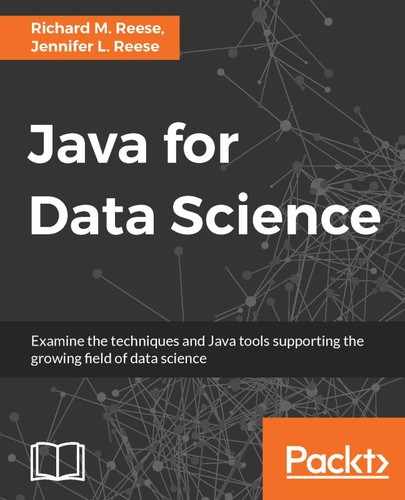In this book, we examine Java-based approaches to the field of data science. Data science is a broad topic and includes such subtopics as data mining, statistical analysis, audio and video analysis, and text analysis. A number of Java APIs provide support for these topics. The ability to apply these specific techniques allows for the creation of new, innovative applications able to handle the vast amounts of data available for analysis.
This book takes an expansive yet cursory approach to various aspects of data science. A brief introduction to the field is presented in the first chapter. Subsequent chapters cover significant aspects of data science, such as data cleaning and the application of neural networks. The last chapter combines topics discussed throughout the book to create a comprehensive data science application.
Chapter 1 , Getting Started with Data Science , provides an introduction to the technologies covered by the book. A brief explanation of each technology is given, followed by a short overview and demonstration of the support Java provides.
Chapter 2 , Data Acquisition, demonstrates how to acquire data from a number of sources, including Twitter, Wikipedia, and YouTube. The first step of a data science application is to acquire data.
Chapter 3 , Data Cleaning , explains that once data has been acquired, it needs to be cleaned. This can involve such activities as removing stop words, validating the data, and data conversion.
Chapter 4 , Data Visualization , shows that while numerical processing is a critical step in many data science tasks, people often prefer visual depictions of the results of analysis. This chapter demonstrates various Java approaches to this task.
Chapter 5 , Statistical Data Analysis Techniques , reviews basic statistical techniques, including regression analysis, and demonstrates how various Java APIs provide statistical support. Statistical analysis is key to many data analysis tasks.
Chapter 6 , Machine Learning, covers several machine learning algorithms, including decision trees and support vector machines. The abundance of available data provides an opportunity to apply machine learning techniques.
Chapter 7 , Neural Networks , explains that neural networks can be applied to solve a variety of data science problems. In this chapter, we explain how they work and demonstrate the use of several different types of neural networks.
Chapter 8 , Deep Learning , shows that deep learning algorithms are often described as multilevel neural networks. Java provides significant support in this area, and we will illustrate the use of this approach.
Chapter 9 , Text Analysis , explains that s ignificant portions of available datasets exist in textual formats. The field of natural language processing has advanced considerably and is frequently used in data science applications. We demonstrate various Java APIs used to support this type of analysis.
Chapter 10 , Visual and Audio Analysis, tells us that data science is not restricted to text processing. Many social media sites use visual data extensively. This chapter illustrates the Java supports available for this type of analysis.
Chapter 11 , Mathematical and Parallel Techniques for Data Analysis , investigates the support provided for low-level math operations and how they can be supported in a multiple processor environment. Data analysis, at its heart, necessitates the ability to manipulate and analyze large quantities of numeric data.
Chapter 12 , Bringing It All Together , examines how the integration of the various technologies introduced in this book can be used to create a data science application. This chapter begins with data acquisition and incorporates many of the techniques used in subsequent chapters to build a complete application.
